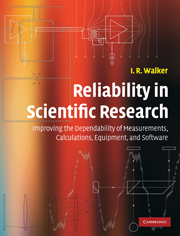 Reliability in Scientific Research
Reliability in Scientific Research Book contents
- Frontmatter
- Contents
- Preface
- List of abbreviations
- 1 Basic principles of reliability, human error, and other general issues
- 2 Mathematical calculations
- 3 Basic issues concerning hardware systems
- 4 Obtaining items from commercial sources
- 5 General points regarding the design and construction of apparatus
- 6 Vacuum-system leaks and related problems
- 7 Vacuum pumps and gauges, and other vacuum-system concerns
- 8 Mechanical devices and systems
- 9 Cryogenic systems
- 10 Visible and near-visible optics
- 11 Electronic systems
- 12 Interconnecting, wiring, and cabling for electronics
- 13 Computer hardware and software, and stored information
- 14 Experimental method
- Index
- References
13 - Computer hardware and software, and stored information
Published online by Cambridge University Press: 05 June 2012
- Frontmatter
- Contents
- Preface
- List of abbreviations
- 1 Basic principles of reliability, human error, and other general issues
- 2 Mathematical calculations
- 3 Basic issues concerning hardware systems
- 4 Obtaining items from commercial sources
- 5 General points regarding the design and construction of apparatus
- 6 Vacuum-system leaks and related problems
- 7 Vacuum pumps and gauges, and other vacuum-system concerns
- 8 Mechanical devices and systems
- 9 Cryogenic systems
- 10 Visible and near-visible optics
- 11 Electronic systems
- 12 Interconnecting, wiring, and cabling for electronics
- 13 Computer hardware and software, and stored information
- 14 Experimental method
- Index
- References
Summary
Introduction
The ubiquity of computers in just about every aspect of experimental work, from their use in preliminary literature searches, through the collection and analysis of data, to the final publication of results, means that the consequences of their imperfections are unavoidable. Although hardware and software problems are both a possible cause of frustrations, the latter can be particularly insidious, and harder to solve.
The failure of hardware is sometimes heralded by unusual physical phenomena such as excessive vibrations or noises. On the other hand, failures of software take place suddenly and without warning. Also, again unlike the situation with hardware, the concept of safety margins (or “derating”) normally does not exist in software design. The enormous complexity of many types of software when compared with hardware makes the former particularly susceptible to unforeseen failure modes. (For example, operating systems and large applications often contain millions, or even tens of millions, of lines of source code.) These characteristics can all make software failures especially troublesome.
Computers and operating systems
Selection
Compared with many other electronic devices, computers (including their hardware, software, data storage, security and interconnection aspects) are generally very unreliable. Hence, and since they play such an important part in so many facets of research, it pays to use high-quality computer equipment and software.
The quality of computer hardware varies over a wide range – from systems of marginal dependability, to ones that can be counted on to give years of reliable service.
- Type
- Chapter
- Information
- Reliability in Scientific ResearchImproving the Dependability of Measurements, Calculations, Equipment, and Software, pp. 487 - 535Publisher: Cambridge University PressPrint publication year: 2011


